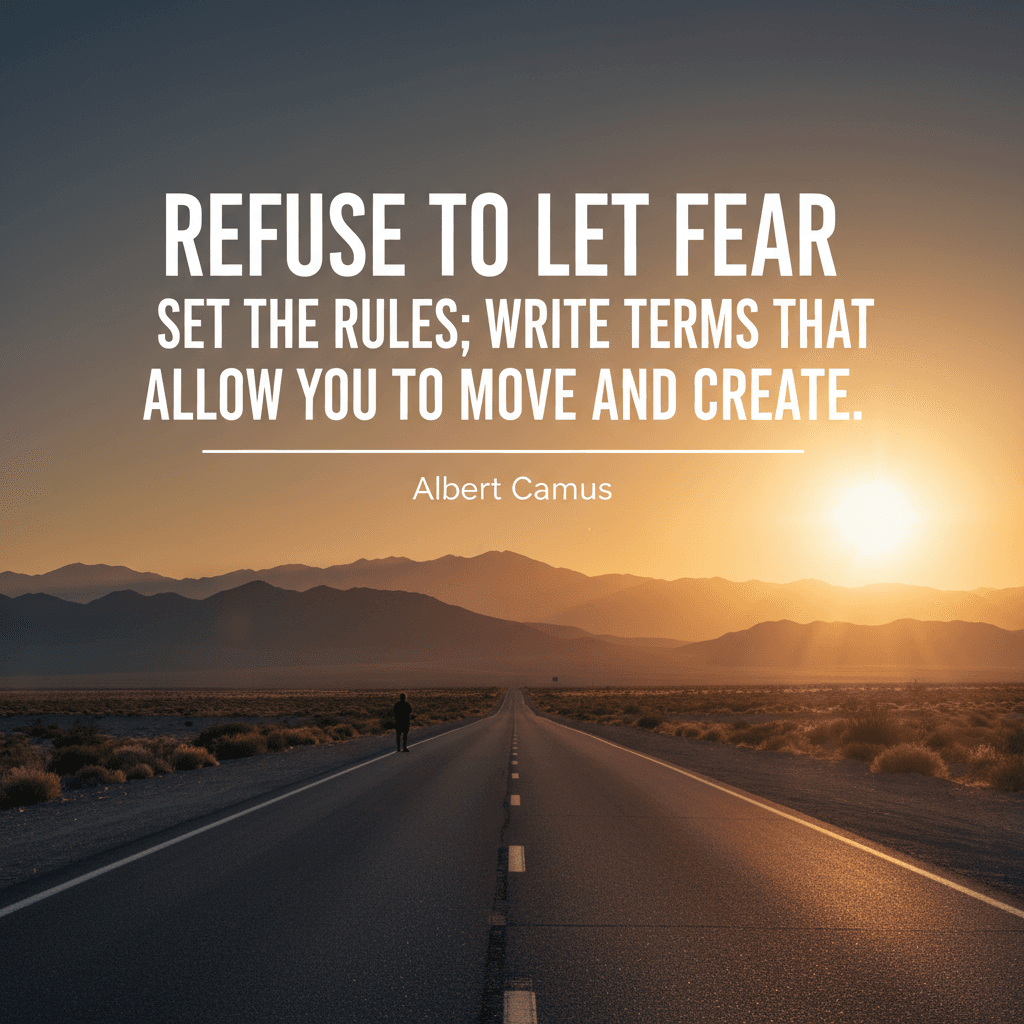Setting Terms Beyond Fear for Creative Freedom

Refuse to let fear set the rules; write terms that allow you to move and create. — Albert Camus
Fear’s Rulebook and the Absurd
At the outset, the aphorism frames fear as an invisible legislator, drafting rules that limit motion and imagination. For Camus, the absurd names the gap between our craving for order and the world’s indifference. When fear writes the code, it smuggles certainty at the cost of possibility. Refusing that authorship does not mean recklessness; it means lucidity—seeing the absurd without capitulating. As Camus’s The Myth of Sisyphus (1942) argues, clarity about meaninglessness can become a source of defiant vitality. Thus the first move is jurisdictional: remove fear from the bench and reclaim the authority to set the terms under which you act.
Revolt as Self‑Written Terms
From this lucidity follows revolt: not a tantrum, but a principled refusal that also affirms a way to live. In The Rebel (1951), Camus defines revolt as a no that implies a deeper yes—a commitment to limits, dignity, and shared measure. Likewise, The Plague (1947) offers Dr. Rieux, who writes his own code—decency and work—and thereby acts despite uncertainty. In that spirit, to write terms that allow you to move and create is to draft a compact you can keep under pressure: rules that favor motion over perfection, contact over isolation, and craftsmanship over control. Having named the absurd, you now negotiate with conditions, not with fear.
Enabling Constraints, Not Shackles
Carrying that forward, the terms that free you often look like constraints. Chosen limits concentrate attention and invite play, whereas fear-imposed limits constrict and stall. The Oulipo writers showed this paradox; Georges Perec’s La Disparition (1969) omits the letter e, yet the constraint unlocks inventiveness. Closer to craft lore, Dr. Seuss wrote Green Eggs and Ham (1960) using just fifty distinct words, turning scarcity into rhythm. Because you select them, enabling constraints become scaffolds: timeboxes, word caps, or one take, then ship. Thus the rule changes from don’t risk to risk in a defined frame, which keeps you moving while insulating the work from panic’s perfectionism.
The Psychology of Moving Anyway
Psychologically, this shift replaces avoidance with approach. Fear narrows perception and biases us toward inaction, but approach goals broaden exploration and creative recombination (Elliot, 1999). Moreover, exposure science shows that doing the feared thing within safe parameters reduces the alarm over time (Foa et al., 2007). Self-authored terms operationalize both insights: a daily page, a fifteen‑minute prototype, or one honest conversation lowers uncertainty enough for action, and repetition rewires the response. In other words, by designing the path, you quiet the guard dog; movement itself becomes the treatment, and creation the proof that fear is no longer setting policy.
Freedom With Measure and Responsibility
Yet self-authorship requires measure, lest freedom curdle into domination. Camus insists on limits that protect human dignity; revolt must not become the new tyranny (The Rebel, 1951). Creation, then, carries responsibility for consequences beyond the studio. Terms that allow you to move should also constrain harm: truthfulness in depiction, consent in collaboration, and repair when your work misfires. By binding yourself to ethical boundaries, you preserve the very space in which freedom breathes. Accordingly, the artist or builder remains answerable to a community, even while refusing fear’s jurisdiction—a balance The Plague (1947) dramatizes through solidarity in action.
A Daily Compact You Can Keep
In practice, the manifesto is brief, renewable, and lived. Each morning, articulate three terms you can keep today—for instance: move once, ship one thing, and protect dignity in all exchanges. Each evening, renew or revise them in light of what the day revealed. This loop turns ideals into feedback and keeps fear from reentering as a shadow lawmaker. Finally, celebrate adherence rather than applause; as The Myth of Sisyphus suggests, meaning emerges from the fidelity of the push, not the promise of arrival. In living these terms, you write a life that moves and creates, because you refuse to let fear write it for you.